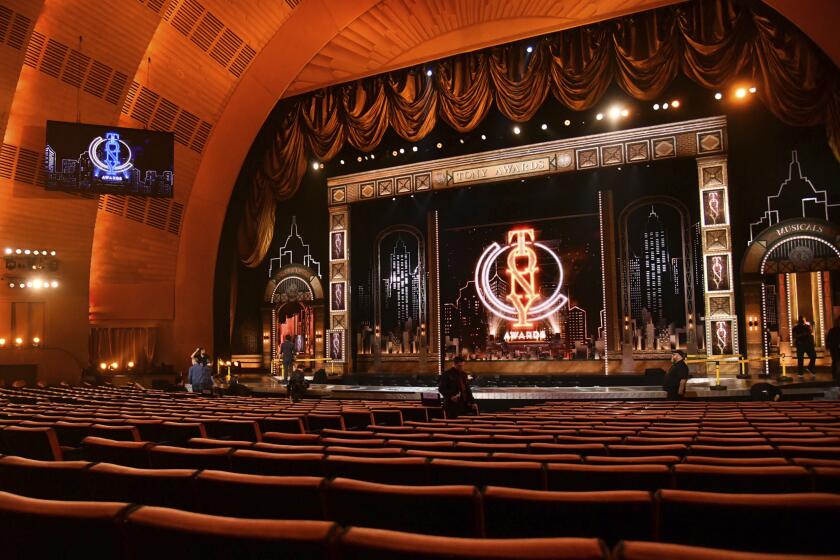Review: Jessica Lang’s vision is far-reaching in company’s program at Irvine Barclay Theatre
- Share via
New York choreographer Jessica Lang has a knack for conceiving a complete universe in each dance — distinctive in its look and mood, sound and atmosphere. She is a ballet illusionist, a more serious and intellectual cousin of the hallucinatory dance company Momix.
In Lang’s signature solo “The Calling,” for example, she conveys religious passion and humility. The dance — an expression of its score, the medieval chant “O Maria, Stella Maris” — is crafted out of spare, pleading gestures and with a costume that constrains the dancer: a voluminous dress that spreads like an open, flat parachute. It is a striking exaggeration of womanhood, and a symbol of the character’s life.
Lang’s visual sense is remarkable, and it has come to characterize her aesthetic. But that reputation is too limiting, as her Jessica Lang Dance company proved Friday night at the Irvine Barclay Theatre. The program of six ballets included a recent work, “Thousand Yard Stare.” The ballet’s title refers to the blank and bewildered gaze of a shell-shocked soldier, and the program noted that Lang interviewed battle veterans and investigated post-traumatic stress and its treatment as research.
The piece begins as a continuous stream of crisply exacting formations. Lang’s outstanding nine dancers march slowly across the stage in profile, stop and lean backward, begin forward again, stopping in midstep with a lifted, flexed foot. It’s a zombie-like procession. They are knocked over, and reverberations of bombs catapult them into remarkable body-twisting leaps. The dancers crawl and clump together to form tunnels. There is fear, cowering and compassion among comrades, an echo of the gentleness in Beethoven’s somber String Quartet No. 15.
Facing front, the dancers look identical in designer Bradon McDonald’s fatigue-green pants and tops; the shirt backs, however, are distinguished by different black-and-white graffiti-like squiggles. A soldier’s individuality is secondary and hidden. Dark stage lighting is penetrated by occasional ominous flashes. This ballet is spare yet evocative, gorgeous throughout.
The other piece not previously performed in Southern California was “Solo Bach” (2008). Short, gracious and buoyant, it is a welcome dance. Performer Patrick Coker faces the backdrop, then turns to greet the audience like a host, with upturned palms, a phrase he repeats several times. He touches his hand to his heart, then extends fingers toward us.
Lang digs into the rhythmic complexities of the Bach partita (all the music was recorded), giving her soloist airy jumps and quickly accented small steps and beats. One of the evening’s standouts, Coker alternated seamlessly between these adagio and allegro moments.
The other four works on the program were presented two years ago at the company’s first local show at the Wallis Annenberg Center for the Performing Arts in Beverly Hills. These pieces are more theatrical, expressions of a single idea. But they also show off the skills of Lang’s dancers, especially Clifton Brown, the Alvin Ailey veteran who brings elegance and gravitas to Lang’s choreography.
The 2010 piece “Among the Stars” suggests the love of a couple now separated, this divide made material by a flowing, shimmering rectangle of fabric (reminiscent of the “river” in Ailey’s “Revelations”). Brown and San Francisco Ballet’s ethereal Yuan Yuan Tan were the original couple for this gala piece. Brown partnered Laura Mead on Friday night, and while they were skillful, their connection was unremarkable. Mead, although a fine ballerina, is perhaps too earthy for the part.
Kana Kimura gave a memory-making performance in “The Calling”; she and Brown were equally intense during the central duet in the night’s closer, “i.n.k” (2011). The black-on-white “i.n.k,” with video art by Shinichi Maruyama and an original Jakub Ciupinski score, was preceded by a companion work, the white-on-black dance film “White,” shot by Maruyama. Taken together, they are a snapshot of Lang’s originality and what’s possible when artistic minds enable one another’s visions.
More to Read
The biggest entertainment stories
Get our big stories about Hollywood, film, television, music, arts, culture and more right in your inbox as soon as they publish.
You may occasionally receive promotional content from the Los Angeles Times.










